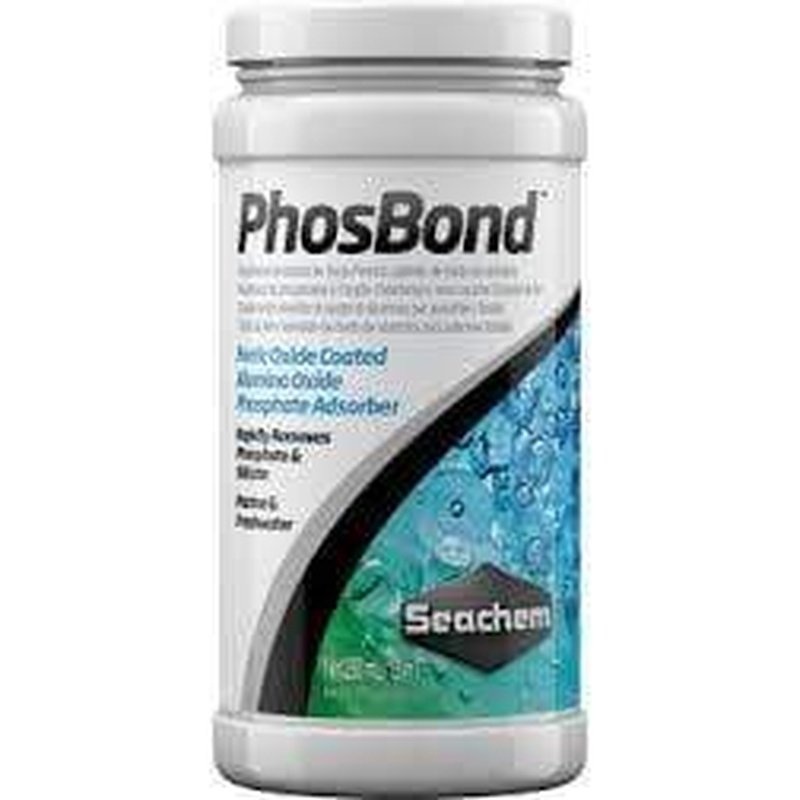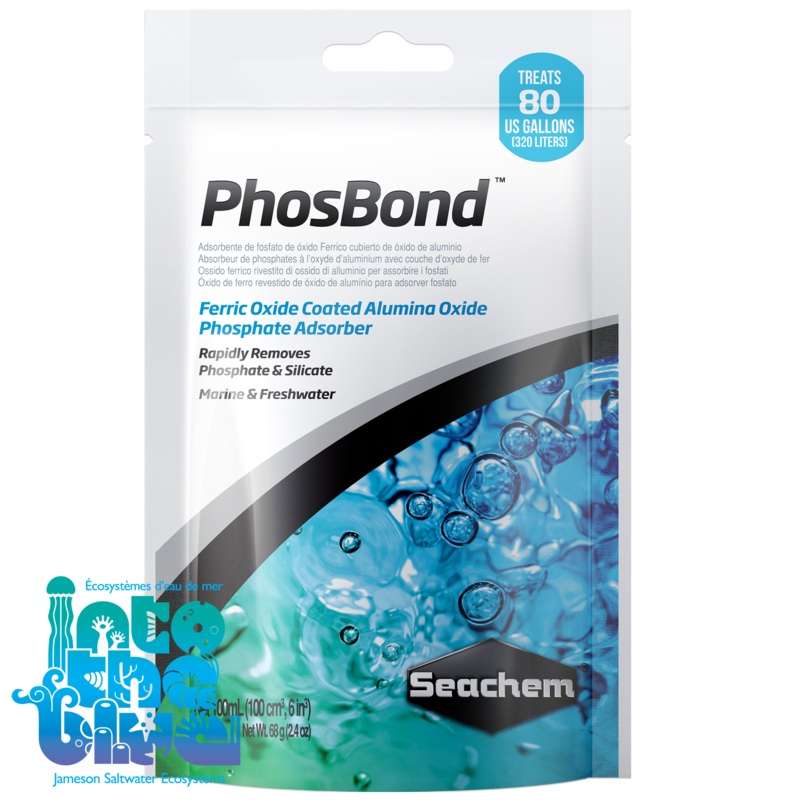 Sale!
Sale! PhosBond is a revolutionary new product that combines the phosphate removing capabilities of both aluminum oxide and granular ferric oxide into a singular material forming a synergistic effect. It rapidly removes phosphates and silicates from saltwater and
PhosBond is a revolutionary new product that combines the phosphate removing capabilities of both aluminum oxide and granular ferric oxide into a singular material forming a synergistic effect. It rapidly removes phosphates and silicates from saltwater and freshwater, combining the best of both types of phosphate removers. Its high porosity and surface area give it a large binding capacity, while its physical strength and integrity assures that it will not break down from mechanical stress.
Directions
For best results, PhosBond should be rinsed before use and placed so as to maximize the flow of water through it but not so that it tumbles against itself in flow. It may be used in a canister filter, media chamber, box filter, or any high flow area of a trickle filter. Use of a filter bag is recommended.
Use 60 mL ( cup) for every 200 L (50 US gallons) saltwater or 400 L (100 US gallons) freshwater. Leave product in place for 4 days, then test phosphate or silicate concentrations with either MultiTest Phosphate or MultiTest Silicate. If the concentration of the component you are trying to decrease has not dropped to around 0.02 mg/L, then replace the PhosBond, otherwise leave in place until levels begin to climb again. As long as concentrations remain under control, the product is not exhausted. Over treating is not recommended. PhosBond is not an exchange resin and does not release anything into the water. It does not leach phosphate or silicate back into the water and may be removed, dried, and returned to service until exhausted. Continuous use of small quantities is better than intermittent use of larger quantities.
FAQ:
How do I use PhosBond? How long does it work and when is it exhausted?A: PhosBond Is best used in smaller quantities and changed frequently. In an environment with an excessively high phosphate reading, PhosBond will exhaust rapidly (4 5 days). Place the product in a high flow rate area and test your phosphate levels, changing as needed. When you see that your level is below 0.2 ppm (mg/L) leave that portion of PhosBond in the filter. Continue to test weekly for phosphate until you see it begin to rise again. You will then know that it is time to change the PhosBond. If you have low levels of phosphate the PhosBond will absorb the silicate in your system. Its inert and safe to leave in your filter.
Company X says that I dont need to replace their phosphate absorber for several months, while your instructions say that PhosBond needs to be replaced every 4 days when reducing phosphate. Doesnt that make PhosBond an inferior product?
A: Not at all! If it takes a phosphate absorber several months to reach its full capacity when the tank has high phosphates, it means that the media is exceptionally slow at absorbing phosphate. PhosBond needs to be replaced every 4 days as long as there is a phosphate problem because, given an infinite amount of available phosphate, PhosBond absorbs phosphate so quickly that it reaches its full capacity in 4 days. The 4 day replacement period is a function of how quickly the media works, not a function of how high a capacity the media has.
How is this different from PhosGuard, PhosNet, and phosfiltrum (aquavitro)?
A: The main difference between these medias is capacity. PhosGuard has the lowest capacity at 0.82 mg/g of PO4 bound, but is the most economical of the four medias. PhosBond has a higher capacity than PhosGuard at 1.19 mg/g of PO4 bound, and combines the benefits of PhosGuard and a pure GFO (strength, high capacity, and rapid phosphate absorption) while still being very economical. PhosNet has the highest capacity of the Seachem phosphate absorbers at 1.41 mg/g of PO4 bound, and is a pure GFO media. Our aquavitro phosfiltrum is a super-high capacity GFO (1.71 mg/g of PO4 bound) that produces very little dust. This media has a higher capacity than any other GFO on the market.
Cost: $25
Free Shipping
We offer free shipping on orders over $30. Please check the free - shipping eligibility at checkout.
Delivery Time:
It usually takes [3-5] business days for standard shipping. Please note that this is an estimated time frame and may be affected by local holidays, and unforeseen circumstances.
 Sale!
Sale! PhosBond - Rapidly removes phosphate & silicate - Ferric oxide coated aluminum oxide phosphate adsorber - High porosity and surface area give it a large binding capacityOverview PhosBond is a revolutionary new product that combines the phosphate removing c
PhosBond
– Rapidly removes phosphate & silicate
– Ferric oxide coated aluminum oxide phosphate adsorber
– High porosity and surface area give it a large binding capacity
Overview
PhosBond is a revolutionary new product that combines the phosphate removing capabilities of both aluminum oxide and granular ferric oxide into a singular material forming a synergistic effect. It rapidly removes phosphates and silicates from saltwater and freshwater, combining the best of both types of phosphate removers. Its high porosity and surface area give it a large binding capacity, while its physical strength and integrity assures that it will not break down from mechanical stress.
Sizes: 100 mL, 250 mL, 500 mL
Comparing Seachem Phosphate Removers
– PhosGuard (Alumina Oxide): 0.87 mg/g PO4 bound
– PhosBond (GFO and Alumina Oxide hybrid): 1.19 mg/g PO4 bound
– PhosNet (GFO): 1.41 mg/g PO4 bound
Directions
For best results, PhosBond should be rinsed before use and placed so as to maximize the flow of water through it but not so that it tumbles against itself in flow. It may be used in a canister filter, media chamber, box filter, or any high flow area of a trickle filter. Use of a filter bag such as The Bag is recommended.
Use 60 mL (1/4 cup) for every 200 L (50 US gallons) saltwater or 400 L (100 US gallons) freshwater. Leave product in place for 4 days, then test phosphate or silicate concentrations with either MultiTest Phosphate or MultiTest Silicate. If the concentration of the component you are trying to decrease has not dropped to around 0.02 mg/L, then replace the PhosBond, otherwise, leave in place until levels begin to climb again. As long as concentrations remain under control, the product is not exhausted. Over treating is not recommended. PhosBond is not an exchange resin and does not release anything into the water. It does not leach phosphate or silicate back into the water and may be removed, dried, and returned to service until exhausted. Continuous use of small quantities is better than intermittent use of larger quantities.
* Information as per Manufacturer
Cost: $25
Free Shipping
We offer free shipping on orders over $30. Please check the free - shipping eligibility at checkout.
Delivery Time:
It usually takes [3-5] business days for standard shipping. Please note that this is an estimated time frame and may be affected by local holidays, and unforeseen circumstances.
There are no reviews yet.
Reviews
There are no reviews yet.